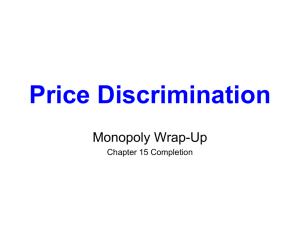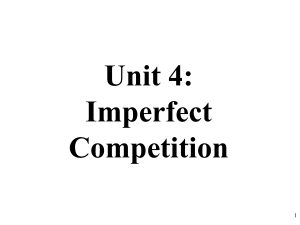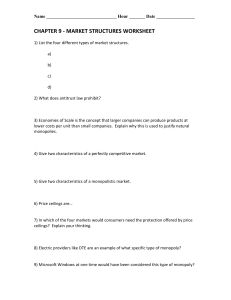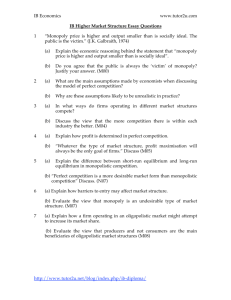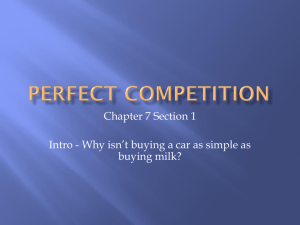AP Micro 4-2 Regulation and Price Discrimination
advertisement
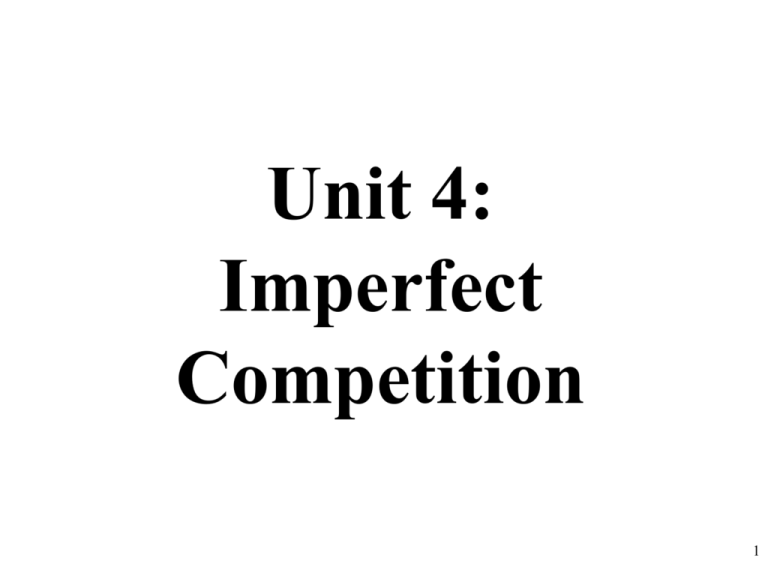
Unit 4: Imperfect Competition 1 REVIEW Name That Concept Rules: 1. Cannot use the word(s) 2. Focus on the concept not word Ex: Price Maker 2 Name That Concept 1. Monopoly 2. Imperfect Competition 3. Barriers to Entry 4. Dead Weight Loss 5. Productive Efficiency 3 Name That Concept 1. Marginal Revenue 2. MR = MC 3. Shut down rule 4. Natural Monopoly 5. Allocative Efficiency 4 Conclusion: A monopoly produces where MR=MC, buts charges the set by the demand curve. How much is the TR, TC and Profit or Loss? P MC ATC $10 Profit =$20 9 8 7 6 D 5 MR 16 17 18 19 20 Q 5 Elastic and Inelastic Range P Total Revenue Test If price falls and TR increases then demand is elastic. Elastic Inelastic $15 10 5 D 1 2 3 4 5 6 7 8 9 10 11 12 13 14 15 16 17 18 TR Total Revenue Test If price falls and TR falls then demand is inelastic. $64 40 20 1 2 3 4 5 6 7 8 Q A monopoly MR will only produce in the elastic range TR Q 6 9 10 11 12 13 14 15 16 17 18 Are Monopolies Efficient? 7 Monopolies are inefficient because they… 1. Charge a higher price 2. Don’t produce enough • Not allocatively efficiency 3. Produce at higher costs • Not productively efficiency 4. Have little incentive to innovate Why? Because there is little external pressure to be efficient 8 Monopolies vs. Perfect Competition Where is CS and PS for a monopoly? P S = MC CS Total surplus falls. Now there is DEADWEIGHT LOSS Pm PS D MR Qm Q 9 Regulating Monopolies 10 What do you think? Monopolies are often regulated by the government. That means that the government sets the price at which a monopoly can operate. Look at a monopoly graph. Where might a government place a price ceiling. Why would it place a price ceiling there? Why Regulate? Why would the government regulate a monopoly? 1. To keep prices low 2. To make monopolies efficient How do they regulate? •Use Price controls: Price Ceilings •Why don’t taxes work? •Taxes limit supply and that’s the problem 12 Where should the government place the price ceiling? 1.Socially Optimal Price P = MC (Allocative Efficiency) OR 2. Fair-Return Price (Break–Even) P = ATC (Normal Profit) 13 Regulating Monopolies Where does the firm produce if it is unregulated? P MC Pm ATC D MR Qm Q 14 Regulating Monopolies PriceOptimal Ceiling at Socially Optimal Socially = Allocative Efficiency P MC Pm Pso ATC D MR Qm Qso Q 15 Regulating Monopolies Price Ceiling Returnprofit Fair Return meansat noFair economic P MC Pm Pso Pfr ATC D MR Qm Qso Qfr Q 16 Regulating Monopolies Unregulated P Socially Optimal MC Fair Return Pm Pso Pfr ATC D MR Qm Qso Qfr Q 17 Natural Monopoly One firm can produce the socially optimal quantity at the lowest cost due to economies scale. P It is better to have only one firm because ATC is falling at socially optimal quantity MC ATC MR D Qsocially optimal Q 18 Price Discrimination 19 Brain Dump • • • • • • • • Monopoly characteristics & causes Monopoly graph Total revenue test Elastic v. inelastic range of a monopoly Monopoly efficiency Socially-optimal price Fair-return price Natural monopoly 20 Price Discrimination • Think of a time when you paid a different price for a good than someone else…for the exact same thing. – Why does that occur? – How does that occur? – Who does that benefit? 21 Price Discrimination Definition: Practice of selling the same products to different buyers at different prices Examples: •Airline Tickets (vacation vs. business) •Movie Theaters (child vs. adult) •All Coupons (spenders vs. savers) •SPHS football games (students vs. parents) 22 PRICE DISCRIMINATION •Price discrimination seeks to charge each consumer what they are willing to pay in an effort to increase profits. •Those with inelastic demand are charged more than those with elastic Requires the following conditions: 1. Must have monopoly power 2. Must be able to segregate the market 3. Consumers must NOT be able to resell product 23 P Qd $11 0 TR MR 0 - 24 Results of Price Discrimination $10 P Qd $11 $10 0 1 TR MR 0 10 10 25 Results of Price Discrimination $10 P Qd $11 $10 $9 0 1 2 TR MR 0 10 19 10 9 $10 $9 26 Results of Price Discrimination $10 $10 $9 $10 $9 P Qd $11 $10 $9 $8 0 1 2 3 TR MR 0 10 19 27 10 9 8 $8 27 Results of Price Discrimination $10 $10 $9 $10 $9 $8 $10 $9 $8 P Qd $11 $10 $9 $8 $7 0 1 2 3 4 TR MR 0 10 19 27 34 10 9 8 7 $7 28 Results of Price Discrimination $10 $10 $9 $10 $9 $8 $10 $9 $8 $7 $10 $9 $8 $7 $6 $10 $9 $8 $7 $6 $5 $10 $9 $8 $7 $6 $5 P Qd $11 $10 $9 $8 $7 $6 $5 $4 0 1 2 3 4 5 6 7 TR MR 0 10 19 27 34 40 45 49 10 $9 $8 $7 $6 $5 $4 $4 29 P Qd $10 $9 $11 0 $10 1 $9 2 $8 3 WHEN PRICE $7 4 $8 DISCIMINATING $6 5 $8 $7 MR = D$5 6 $4 7 $8 $7 $6 $10 $9 $8 $7 $6 $5 $10 $9 $8 $7 $6 $5 $10 $10 $9 $10 $9 $10 $9 TR MR 0 10 19 27 34 40 45 49 10 $9 $8 $7 $6 $5 $4 $4 30 Regular Monopoly vs. Price Discriminating Monopoly P MC Pm ATC D MR Qm Q 31 A perfectly discriminating can charge each person differently so the Marginal Revenue = Demand P MC ATC D MR Q 32 A perfectly discriminating can charge each person differently so the Marginal Revenue = Demand Identify the Price, Profit, CS, and DWL P MC ATC D =MR Qnm Q 33 A perfectly discriminating can charge each person differently so the Marginal Revenue = Demand Identify the Price, Profit, CS, and DWL P MC ATC D =MR Price Discrimination results in several prices, more profit, no CS, and a higher socially optimal quantity Q Q nm 34 Can You Do The Following? 1.Draw a monopoly making a profit at long-run equilibrium and identify price, quantity, and profit. 2. Draw a perfectly competitive industry AND firm at long-run equilibrium 3. Draw a price discriminating monopoly at equilibrium and label price, quantity, MR, and profit 35
